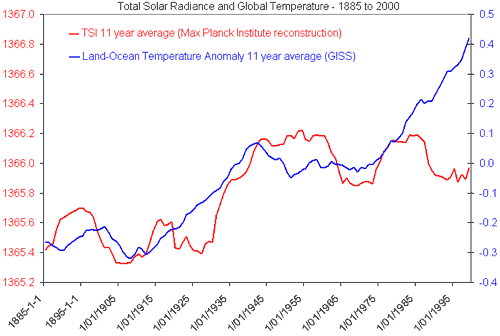This just in - the sun affects climate
Posted on 8 June 2009 by John Cook
A new Daily Tech blog post is propagating through the blogosphere, claiming a new NASA study attributes recent warming to the sun. The "new research report" is a NASA press release released in May 2008. The press release mentions that "fluctuations in the solar cycle impacts Earth's global temperature by about 0.1 degree Celsius, slightly hotter during solar maximum and cooler during solar minimum". This impact of the solar cycle on climate has been known for years.
Douglass 2004 calculates that due to the 1W/m2 change in Total Solar Irradiance (TSI) due to the solar cycle, you would theoretically expect a change in global temperature of 0.05°C. Instead, he observes a change of 0.1°C - he attributes the difference to positive feedback. White 1997 finds sea surface temperatures change by 0.1°C due to the 11 year solar cycle, looking at data from 1955 to 1994. Scafetta 2005 finds the 11 year solar cycle causes a change of 0.11°C in global temperatures going back to 1860. Camp 2007 found a signal of 0.18°C in global temperature attributable to the 11 year solar cycle.
However, the sun has shown little to no long term trend since the 1950's. This means that when modern global warming trend began in the 1970's, the correlation between sun and climate broke down. In fact, the long term trend for solar activity is that of cooling. Not only is the sun not contributing to global warming, it has had a slight, long term cooling effect.

Figure 1: 11 year averages of Total Solar Irradiance (TSI, Max Planck Institute) and Global Temperature (GISS).
This break down in correlation is the reason why so much peer reviewed research investigating the link between sun and climate has concluded that the sun is not a major factor in global warming. Ammann 2007, Lockwood 2007, Foukal 2006, Scafetta 2006, Usoskin 2005 and many other papers (here is a more comprehensive list) all find the sun has had a minimal impact on global warming over the past 30 years.
Blaming global warming on the sun continues to be the #1 skeptic argument. When we gaze up into the huge, flaming ball in the sky (not for too long, I hope), it seems intuitive. How can you argue with such simple yet persuasive logic: "sun big, people small". I've even read one skeptic post comparing the size of the sun to the size of a CO2 molecule to hammer home the point.
However, focusing on one fact (the sun affects climate) while ignoring the broader picture (the sun is cooling) leads to the erroneous conclusion that the sun is causing global warming. Perhaps the only effective counter argument to "sun big, people small" is an equally simple argument: "earth warming, sun cooling".































 Arguments
Arguments






























The ACRIM vs PMOD debate is a question over which composite of satellite TSI data is more accurate. ACRIM shows a slight warming trend. PMOD shows a slight cooling trend. Even using the ACRIM data, the warming trend is so slight, it is insufficient to explain the steep warming over the past 35 years. However, various independent measurements of solar activity all show closer agreement to the PMOD reconstruction which indicates the sun has been showing a cooling trend over the last few decades. This is explained in detail at Determining the long term solar trend.
UPDATE: I read the Scafetta paper which claims the ACRIM data (which shows slight warming) is more accurate than the PMOD data (slight cooling) because it shows closer agreement with the TSI reconstruction by Krivova and Solanki. I found this curious as Krivova 2007 itself compares its results to PMOD and finds close agreement. So I contacted Sami Solanki, one of the authors of the Krivova model. He replied (very promptly, a very approachable scientist) that they had actually written a paper responding to Scafetta's claims that is currently awaiting publication. I will keep everyone posted when the paper is published.
Incidentally, Krivova's TSI reconstruction is the data I use in Figure 1 above.
UPDATE 2 Nov 2009: The response from Solanki and Krivova has been published. I summarise it's findings in ACRIM vs PMOD, the rematch.